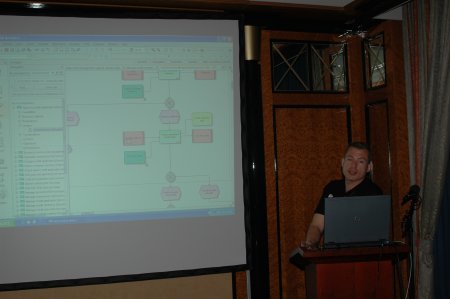
One of the key feature of ARIS UserDay is the many hands-on sessions where users can try the latest version of the different ARIS products. Today in the morning, the hands-on for ARIS SOA Architect and ARIS Business Rules Designer took place.
Directly after Karl’s keynote, the ARIS SOA Architect hands-on session started. All computers provided were used, which shows to me that SOA is a very hot topic. The session was led by Jörg Klückmann from the product marketing department. In contrast to previous years, this time the SOA session focused on a more business oriented way of SOA not focusing so much on technical details like BPEL.
Jörg started the session with giving a short overview of SOA and why it should be approached from a business perspective and not driven by technology. As a first step, participants created a new business service. Creating a business service involves describing the service so that it can be re-used. ARIS provides different possibilities to describe services like assigning capabilities to a service or using quantitative measure like specifying the costs involved for using a service.
Afterwards, the newly created business service was added to the service architecture. Of course, business services are not just created for the sake of having a service repository, but they are also invoked in business processes. Therefore, the participants added the newly created business service to a business process and later on derived the executable BPEL process model out of it. After the SOA hands-on session, the ARIS Business Rules Designer session immediately started. Again, all places were taken and the participants followed the tutorial eagerly. The Business Rules hands-on was led by Julia Wagner, who is the product owner of ARIS Business Rules Designer. Julia started by motivating the use of business rules. She said that business rules can make business process models less complex, because the decision logic is moved out of the process models. This prevents having complex branches and conditions in a process model.
After this introduction, participants started modelling a business rule. As a first step, a vocabulary was created to define the terms used in the business rule. The vocabulary also defines where the data the decision is based on is taken from. Afterwards, the interesting attributes where added to a rule sheet. The rule sheet defines the actual decision logic. Julia showed that the rule sheet might contain logical errors, which can be found with ARIS. Participants completed the rule and ran a test on it. It seemed to me that participants were satisfied with the hands-on. Many participants started playing around with the tools, e.g. defining more advanced rules as shown during the tutorial. That, of course, is the best moment for an ARIS developer - seeing people actually using the tools developed!














